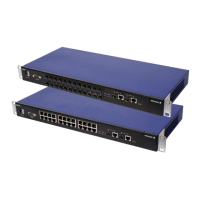IndexIndex
1. Frame Check Sequence (FCS)
When a frame has successfully been extracted in Layer 1, the Frame
Check Sequence (FCS) is recalculated in order to detect bit-errors.
Frames with detected bit-errors are discarded. The introductory 8-byte
preamble and the ending 4-byte FCS are peeled off, and then the packet
is delivered to Layer 2.
2. Null Addresses
All packets, unless discarded in earlier phases, are checked against the
basic requirements before further processing. Invalid packets are
discarded. These are the basic requirements for valid packets:
Layer 2 destination address may not be null.
Layer 2 source address may not be null.
Layer 2 source address may not be a multicast type address.
3. PAUSE Message
If the frame is a Layer 2 PAUSE messages, intended for Layer 2 flow
control, it is discarded.
4. Port and Bridge States
The processing at Layer 2 depends on the bridge state and the port state.
The states are determined based on either the operator configuration, or
EFN324 internal algorithms processing BPDUs (see the next step).
When the bridge or port is disabled, there is no further processing and the
packet is discarded immediately.
Packets are also discarded when the Spanning Tree Protocol (STP) or
Rapid Spanning Tree Protocol (RSTP) is in a blocking, listening or learning
state. However, in the learning state, the bridge table is updated,
according to the contents of the validated packet.
5. Bridge Protocol Data Units (BPDU)
Configuration BPDUs, that is, configuration messages sent by STP or
RSTP, are extracted from the stream of packets arriving at a port. They are
processed by the EFN324 itself. This processing of BPDUs is
unconditional and performed in all states.

